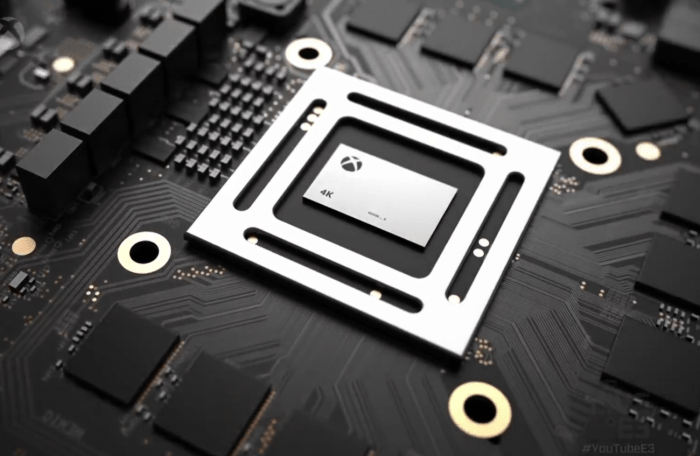Project Scorpio’s Impact on Game Development
Project Scorpio, later known as the Xbox One X, was a revolutionary console in terms of its raw power. This led to significant changes in game development practices and design decisions, pushing the boundaries of what was possible on consoles.
Impact on Game Development Practices
The sheer power of Project Scorpio allowed developers to achieve unprecedented levels of visual fidelity. The ability to render games at 4K resolution with high frame rates opened up new possibilities for game design. Developers could now create more detailed environments, intricate character models, and immersive lighting effects.
- Increased Visual Fidelity: Project Scorpio’s powerful hardware enabled developers to create games with significantly higher visual fidelity. This meant more detailed textures, higher polygon counts, and more realistic lighting effects, resulting in stunningly immersive gaming experiences.
- Native 4K Resolution: The console’s ability to render games at native 4K resolution was a game-changer. This meant that players could experience games with a level of clarity and detail that was previously impossible on consoles.
- High Frame Rates: Project Scorpio’s hardware also allowed developers to target higher frame rates, typically 60 frames per second or even higher. This resulted in smoother and more responsive gameplay, enhancing the overall experience.
- Enhanced Lighting and Shadow Effects: The console’s powerful GPU allowed for more advanced lighting and shadow effects, creating more realistic and immersive environments.
Challenges of Developing for a 4K-Capable Console
While the increased power of Project Scorpio presented developers with exciting opportunities, it also introduced new challenges. Developing games for a 4K-capable console required significant technical expertise and optimization skills.
- Optimization for 4K Resolution: Rendering games at 4K resolution required developers to optimize their games to handle the increased workload. This involved techniques such as texture compression, LOD (Level of Detail) management, and efficient shader code.
- Balancing Performance and Visual Fidelity: Developers had to strike a delicate balance between achieving high visual fidelity and maintaining a smooth frame rate. This often involved making compromises and prioritizing certain aspects of the game’s visual presentation.
- Increased Development Costs: The increased complexity of developing games for a 4K-capable console often led to higher development costs. Developers needed to invest in more powerful hardware, specialized software, and additional resources to achieve the desired level of visual fidelity.
Examples of Games that Utilize Project Scorpio’s Capabilities
Several games fully leveraged the power of Project Scorpio, showcasing the potential of true 4K gaming.
- Forza Horizon 4: This racing game was a showcase of Project Scorpio’s capabilities, featuring stunning visuals, high frame rates, and a vast open world.
- Gears of War 4: This action-packed shooter benefited significantly from Project Scorpio’s power, delivering breathtaking environments and smooth gameplay.
- State of Decay 2: This zombie survival game utilized Project Scorpio’s hardware to create a massive and detailed open world, with impressive draw distances and realistic lighting effects.
The Future of Gaming: Project Scorpio Deliver True 4k Gaming
The world of gaming is constantly evolving, and the pursuit of ever-increasing realism and immersion is a driving force behind this evolution. While Project Scorpio delivered a significant leap forward with its 4K capabilities, the future holds even more exciting possibilities beyond mere resolution. The relentless pursuit of enhancing visual fidelity and creating truly immersive experiences is leading to the adoption of new technologies and trends, pushing the boundaries of what we consider possible in gaming.
The Impact of Display Technologies, Project scorpio deliver true 4k gaming
Advancements in display technologies are playing a crucial role in shaping the future of gaming. Beyond 4K resolution, technologies like HDR (High Dynamic Range) and high refresh rates are revolutionizing the gaming experience, bringing a new level of realism and responsiveness to the screen.
- HDR: HDR enhances the dynamic range of colors, allowing for greater contrast and a wider spectrum of shades, resulting in a more vibrant and lifelike visual experience. This is particularly impactful in games with rich environments and detailed lighting, creating a sense of depth and realism that was previously unattainable.
- High Refresh Rates: High refresh rates, measured in Hertz (Hz), refer to the number of times a display refreshes its image per second. Higher refresh rates result in smoother and more responsive gameplay, reducing motion blur and improving the overall experience, especially in fast-paced action games where split-second decisions can make the difference between victory and defeat.
These advancements in display technologies are not just about aesthetics; they enhance the overall gameplay experience by providing a more immersive and engaging visual environment. As these technologies become more widely adopted, we can expect to see even more sophisticated and realistic game worlds, further blurring the lines between reality and the virtual realm.
The Evolution of Visual Fidelity
The pursuit of ever-increasing visual fidelity is another defining aspect of the future of gaming. Developers are constantly exploring new techniques and technologies to create more realistic and immersive environments, pushing the boundaries of what is possible with current hardware.
- Ray Tracing: Ray tracing is a rendering technique that simulates the behavior of light, creating more realistic lighting effects and shadows. This results in a more immersive and visually stunning experience, bringing a new level of realism to game worlds. Ray tracing has the potential to revolutionize the way we experience game environments, making them feel more lifelike and believable.
- Advanced AI: Artificial intelligence (AI) is playing an increasingly important role in game development, particularly in creating more realistic and believable non-player characters (NPCs). AI-powered NPCs can react more realistically to player actions, making the game world feel more alive and dynamic. This advancement can lead to more engaging and unpredictable gameplay experiences, as players encounter NPCs that can adapt to their strategies and challenge them in new and unexpected ways.
These advancements in visual fidelity and AI are paving the way for a future where game worlds are indistinguishable from reality, blurring the lines between the virtual and the real. The future of gaming is not just about higher resolutions; it’s about creating experiences that are more immersive, engaging, and emotionally impactful than ever before.
Project Scorpio’s Legacy
Project Scorpio, later rebranded as the Xbox One X, was a groundbreaking console that pushed the boundaries of gaming technology. It left an indelible mark on the gaming landscape, serving as a catalyst for innovation and setting new standards for console gaming.
The Impact on Gaming Innovation
Project Scorpio’s legacy is deeply intertwined with its role in driving innovation within the gaming industry. The console’s ambitious goal of delivering true 4K gaming at 60 frames per second demanded significant advancements in hardware and software. This pursuit of high-fidelity visuals and smooth performance led to breakthroughs in graphics processing, memory technology, and game development techniques.
- Advanced Graphics Processing: Project Scorpio introduced a powerful custom GPU that enabled the console to render games at 4K resolution with exceptional detail and visual fidelity. This advancement significantly improved the overall visual experience for gamers, setting a new benchmark for console graphics.
- High-Speed Memory: To handle the demanding requirements of 4K gaming, Project Scorpio was equipped with a high-bandwidth GDDR5 memory system. This enabled faster data transfer speeds, reducing loading times and enhancing gameplay smoothness. This innovation paved the way for future consoles to prioritize memory performance for improved gaming experiences.
- Enhanced Game Development Techniques: The development of Project Scorpio pushed game developers to adopt new techniques and tools to leverage the console’s advanced capabilities. This led to the creation of innovative game engines and rendering techniques that optimized performance and visual quality, setting the stage for future game development advancements.
Project scorpio deliver true 4k gaming – Project Scorpio, the Xbox One X, was more than just a console; it was a testament to the power of innovation and a glimpse into the future of gaming. It showed the world what was possible, pushing the boundaries of what we thought we could achieve. Though it may not be the latest and greatest console on the market, its legacy lives on. It laid the groundwork for future advancements in console gaming, paving the way for even more immersive and breathtaking experiences. And that’s a legacy worth celebrating.
Project Scorpio promises to deliver true 4K gaming, a dream for many gamers. But let’s be honest, sometimes even the most impressive tech can feel a little…well, “irritating.” Like that time McDonald’s tried to get us all moving with their Happy Meal activity trackers, which, let’s face it, didn’t exactly inspire a love for fitness.
Anyway, hopefully Project Scorpio will be all about the smooth gameplay and not the questionable marketing gimmicks.
 Standi Techno News
Standi Techno News

